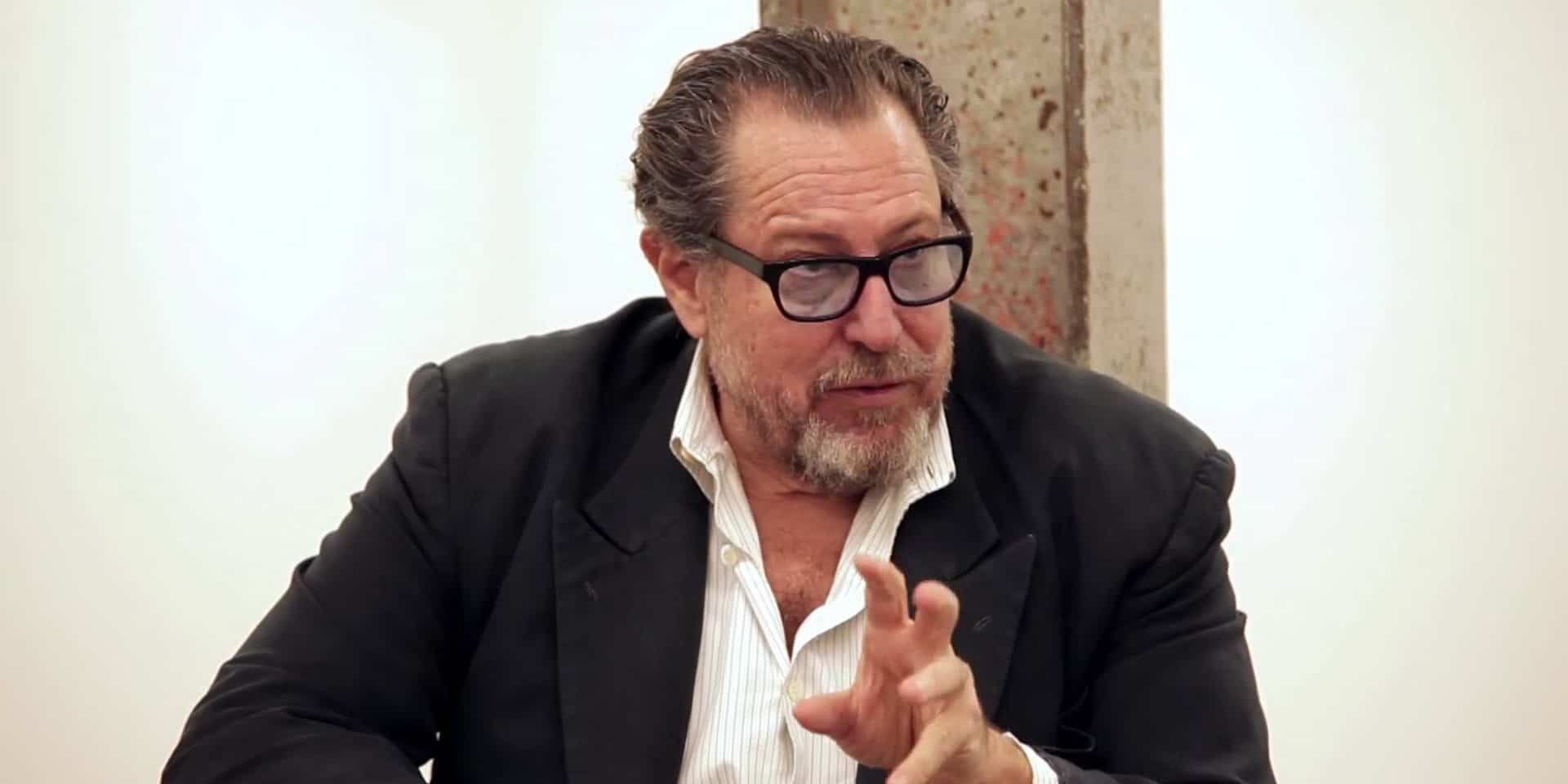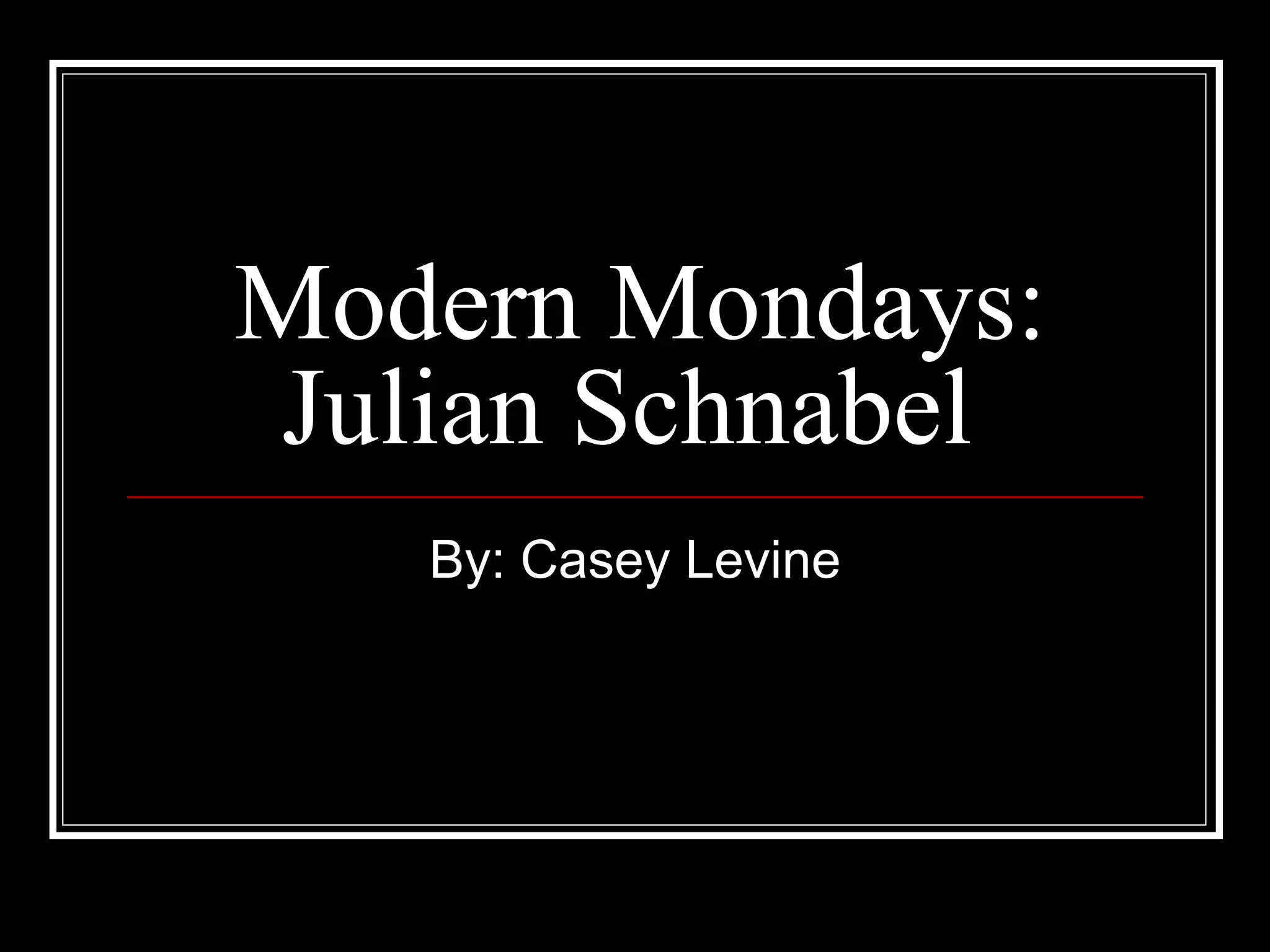Julian Schnabel Net Worth: Understanding The Financial Picture Of A Prominent Artist
Have you ever wondered about the money behind the art, or perhaps, what a celebrated artist might be worth? It's a question many people ask, especially when thinking about figures who have made a really big impact on the art scene. When we consider someone like Julian Schnabel, a name that certainly stands out in contemporary art and even film, the question of his financial standing, his net worth, just naturally comes up.
People often feel a sense of curiosity about how much wealth someone like him might have gathered over the years. It's not just about a number, you know, but more about understanding the different paths a creative person can take to build a substantial fortune. So, that's what we are going to look at here, trying to get a clearer picture of Julian Schnabel's financial journey and what might contribute to his overall wealth, too it's almost.
This discussion really helps us think about the value of art, the business side of being a famous artist, and even how other creative ventures, like filmmaking, can play a part. It's quite interesting, in a way, to see how these different aspects all come together for someone who has truly made his mark in so many areas, like your, artistic pursuits and more, you know.
Table of Contents
- Julian Schnabel: A Brief Look at His Life
- The Beginnings of an Artistic Path
- Breaking Through: The Rise of a New Expression
- Art Market Impact: How His Works Find Value
- Beyond the Canvas: Schnabel's Foray into Film
- Sources of Wealth: A Multifaceted Approach
- Understanding the "Net Worth" Figure
- Frequently Asked Questions About Julian Schnabel's Net Worth
- The Lasting Influence of an Artist
Julian Schnabel: A Brief Look at His Life
Julian Schnabel is a person known for many things. He is a painter, a sculptor, and a filmmaker, too. His work has really caught the eye of people all over the world, you know. He has a very distinct style, which is something many people talk about, actually.
He was born in New York City, which is a really big place. Later, his family moved to Texas, which is a completely different kind of place, so. His early life was pretty much like many others, but he had a very strong leaning towards art from a pretty young age, it seems.
He eventually found his way back to New York, which is often seen as a center for art. That's where he really started to make his name, in fact. His career began to take off in the late 1970s, and he quickly became a very important figure in the art world, you know.
Personal Details and Bio Data of Julian Schnabel
| Detail | Information |
|---|---|
| Full Name | Julian Schnabel |
| Date of Birth | October 26, 1951 |
| Place of Birth | New York City, USA |
| Nationality | American |
| Occupation | Artist (Painter, Sculptor), Filmmaker |
| Known For | Neo-Expressionist paintings, Plate Paintings, Films like "Basquiat," "The Diving Bell and the Butterfly" |
| Education | University of Houston, Whitney Museum of American Art Independent Study Program |
| Spouse(s) | Various relationships, including Jacqueline Beaurang, Olatz López Garmendia, May Andersen |
| Children | Has several children, including Vito Schnabel, Lola Schnabel, Stella Schnabel |
The Beginnings of an Artistic Path
Julian Schnabel's journey into art began quite early, you know. He went to the University of Houston, where he studied art, which is a fairly common path for artists, naturally. After that, he also took part in a program at the Whitney Museum of American Art, which is a very well-known place for art study in New York, so.
These early experiences really helped shape his artistic ideas and his way of seeing things. He was soaking up a lot of different influences, and you could tell he was developing a very unique voice, in a way. He wasn't just following what others were doing, which is pretty typical for artists who go on to become really famous, you know.
He spent time in Europe too, which is something many artists do to get new ideas and see old masters' works. This period of his life was very important for his growth as an artist, as a matter of fact. He was gathering all these experiences that would later show up in his paintings and sculptures, too.
Breaking Through: The Rise of a New Expression
The late 1970s and early 1980s were a big time for Julian Schnabel, honestly. He really came into his own during this period, and his art started to get a lot of attention, you know. He was part of a movement that people called Neo-Expressionism, which was a kind of return to painting with strong feelings and very bold brushstrokes, basically.
His "plate paintings" are what many people remember most from this time, you know. He would take broken ceramic plates and attach them to large canvases, then paint over them. This made the surfaces of his paintings very rough and textured, which was quite new and exciting for many people, in fact. It was a very distinct style that really made him stand out, so.
These works were huge, very expressive, and they really grabbed your eye. They caused a bit of a stir in the art world, you know, and people had strong opinions about them. But whether people loved them or not, they certainly got people talking, and that's often a sign of an artist making a real impact, pretty much.
His shows in New York and other big cities were often sold out, which is a very good sign for an artist's career, you know. Galleries were keen to show his work, and collectors were eager to buy it, which certainly contributed to his early financial success, obviously.
The scale of his works, too, was often quite grand. He wasn't afraid to work on very large pieces, which made them even more impressive, you know. This kind of ambition is something that often sets apart artists who reach a certain level of fame and, well, fortune, in a way.
Art Market Impact: How His Works Find Value
When we talk about the net worth of an artist like Julian Schnabel, a big part of it comes from the value of his art, you know. His paintings and sculptures are sold in galleries and at auctions, and they often fetch very high prices, which is a pretty clear indicator of his standing in the art market, basically.
The prices for his works can vary a lot, depending on the size, the specific series, and how important the piece is considered within his overall body of work. Some of his most iconic plate paintings, for example, have sold for millions of dollars, which is a lot of money, as a matter of fact.
Art dealers and collectors often see his pieces as very important examples of a particular art movement, you know, which adds to their long-term value. When an artist's work is seen as historically significant, it tends to hold its value, or even go up, over time, so.
Auction houses like Sotheby's and Christie's regularly feature his works in their sales of contemporary art. These sales are very public, and the prices achieved there often set the standard for other pieces by the artist, too. It's a bit like a stock market for art, in a way, with prices going up and down based on demand and other factors, you know.
His reputation as an artist who changed things in the 1980s, and who continues to make interesting work, also helps keep the demand for his art strong. People want to own a piece of that history, you know, a piece by someone who really made a difference, pretty much.
He also produces new works regularly, which means there's a constant supply, though often limited, of his art available. This ongoing creation and exhibition of new pieces keeps him relevant and keeps his name in the public eye, which is very important for an artist's market value, obviously.
Beyond the Canvas: Schnabel's Foray into Film
What's really interesting about Julian Schnabel, and something that definitely adds to his overall public profile and, arguably, his net worth, is his work as a filmmaker, you know. He didn't just stick to painting and sculpture; he decided to tell stories on the big screen, too, which is a pretty big jump for an artist, actually.
His first film, "Basquiat," came out in 1996. It was about his friend, the artist Jean-Michel Basquiat, and it got a lot of attention. This movie showed that Schnabel could direct a film, and he could tell a compelling story, which was quite a surprise to many people, in fact.
Then came "Before Night Falls" in 2000, which was also very well-received. It even earned Javier Bardem an Academy Award nomination for his acting, you know. This film really solidified Schnabel's place as a serious director, not just an artist dabbling in movies, so.
But it was "The Diving Bell and the Butterfly" in 2007 that really made a huge splash. This film got him the Best Director award at the Cannes Film Festival, and it was nominated for four Academy Awards, including Best Director, you know. This kind of recognition in Hollywood definitely boosts a person's standing and can open up new financial opportunities, pretty much.
Making films, especially successful ones, can be very profitable, you know. Directors get paid for their work, and if a film does well, they might get a share of the profits, too. So, his film career is certainly another stream of income that contributes to his financial picture, obviously.
These films also brought his name to a much wider audience, people who might not have known him just from his art. This broader recognition can indirectly help his art market, too, by making him a more widely known and talked-about figure, in a way.
Sources of Wealth: A Multifaceted Approach
So, when we consider Julian Schnabel's net worth, it's pretty clear it doesn't just come from one place, you know. It's a combination of several different things, which is typical for many successful people who have long careers, as a matter of fact.
First and foremost, there are his art sales. This is probably the biggest piece of the puzzle. His paintings and sculptures, especially those highly sought-after pieces from his early career, command very high prices at auctions and through private sales, so. This income stream has been pretty consistent for decades, you know.
Then, we have his film career. While perhaps not as consistent as his art sales, the fees he earns from directing, and potentially a share of film profits, definitely add up. Being a respected filmmaker adds another layer to his earning potential, too.
There's also the possibility of real estate holdings. Many successful individuals, especially those with significant wealth, invest in properties. Artists often own studios, homes, and sometimes even commercial spaces, which can appreciate in value over time, you know. This is a very common way for people to build wealth, pretty much.
He might also have income from other ventures, like perhaps consulting or licensing his name or images for certain projects, though this is less publicized. Public figures often have various ways they can earn money beyond their main work, in a way.
And let's not forget about his own art collection. Artists often collect art themselves, and if they bought pieces by other significant artists, those works could also increase in value over time, becoming part of their overall assets, you know. This is a fairly common practice in the art world, too.
All these different parts, the art, the films, potential investments, they all come together to form his total financial standing. It's a very good example of how a creative person can build a very substantial amount of wealth through various talents and opportunities, obviously.
Understanding the "Net Worth" Figure
Figuring out an exact net worth for someone like Julian Schnabel can be a bit tricky, honestly. Public figures often have private finances, and the true value of their assets isn't always something that's openly shared, you know. So, any number you see online is usually an estimate, basically.
These estimates are often based on public records of art sales, known film projects, and general market knowledge about how much people in his position might earn. They try to put together a picture using all the available bits of information, as a matter of fact.
The value of art can also change. What a painting is worth today might be different next year, you know. The art market can go up and down, just like any other market. So, the value of his personal collection, or the prices his works fetch, are not always fixed, so.
Also, a net worth figure includes not just cash, but also the value of all assets: his art, his properties, any investments he might have, and so on. It's a total sum of everything he owns, minus any debts he might have, you know. It's a pretty comprehensive calculation, in a way.
Given his long and very successful career in both art and film, it's pretty safe to say that Julian Schnabel's net worth is quite substantial. He has been at the top of his game for many years, and that kind of sustained success usually translates into significant financial well-being, pretty much. It's a testament to his talent and his ability to stay relevant in very competitive fields, obviously.
For more general information about how artists earn money and build their careers, you can Learn more about art and artists on our site. It gives you a broader perspective on the art world's financial side, too.
Frequently Asked Questions About Julian Schnabel's Net Worth
How much is Julian Schnabel estimated to be worth?
While exact figures are not publicly disclosed, estimates of Julian Schnabel's net worth often place it in the tens of millions of dollars, or even higher, you know. These estimates are based on his extensive art sales, his successful film career, and his overall long-standing presence in the high-value art market, so. It's a pretty significant sum, in fact.
What are the primary sources of Julian Schnabel's wealth?
Julian Schnabel's wealth comes mainly from the sale of his artworks, which include his famous paintings and sculptures. Additionally, his successful career as a film director, with acclaimed movies like "The Diving Bell and the Butterfly," contributes significantly to his earnings, too. He might also have income from investments and other ventures, pretty much.
Are Julian Schnabel's artworks still highly valued in the art market today?
Yes, Julian Schnabel's artworks continue to be highly valued and sought after in the contemporary art market, you know. His pieces regularly appear in major auction sales and are held in important private and public collections around the world. His historical significance in the Neo-Expressionist movement helps maintain strong demand and high prices for his art, as a matter of fact.
The Lasting Influence of an Artist
Julian Schnabel has certainly left a very big mark on the art world, and also on cinema, you know. His influence goes beyond just the financial figures we've been talking about, in a way. He changed how many people looked at painting in the 1980s, and he showed that an artist could cross over into other creative fields, too, very successfully.
His bold style, his use of unusual materials, and his fearless approach to art and storytelling have inspired many other artists and filmmakers. He's a figure who always seems to push boundaries, which is something people really remember, pretty much.
Even today, his work is studied, exhibited, and talked about. He continues to create new pieces, and his presence in the cultural conversation remains strong. This ongoing relevance is a key part of his enduring legacy, you know, and it also helps keep his artistic output, and thus his financial standing, very robust, obviously.
To learn more about his artistic contributions and to explore contemporary art here, you can find many resources about his exhibitions and his impact on art history. His story is a compelling example of how talent, hard work, and a bit of daring can lead to truly remarkable achievements, both creatively and financially, you know.

Julian Schnabel Net Worth - Net Worth Post

Julian Schnabel | PPT

Julian Schnabel - Guild Hall